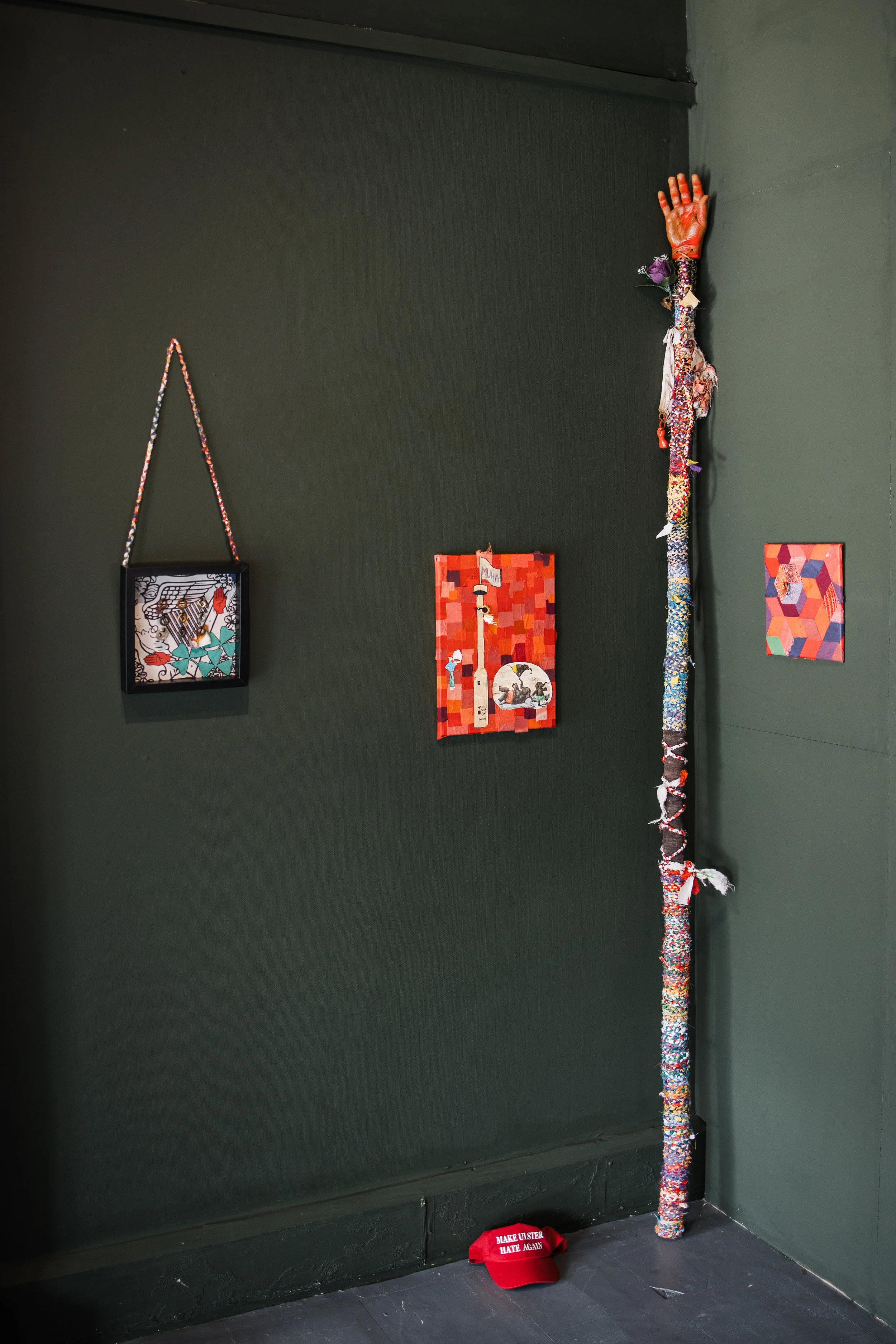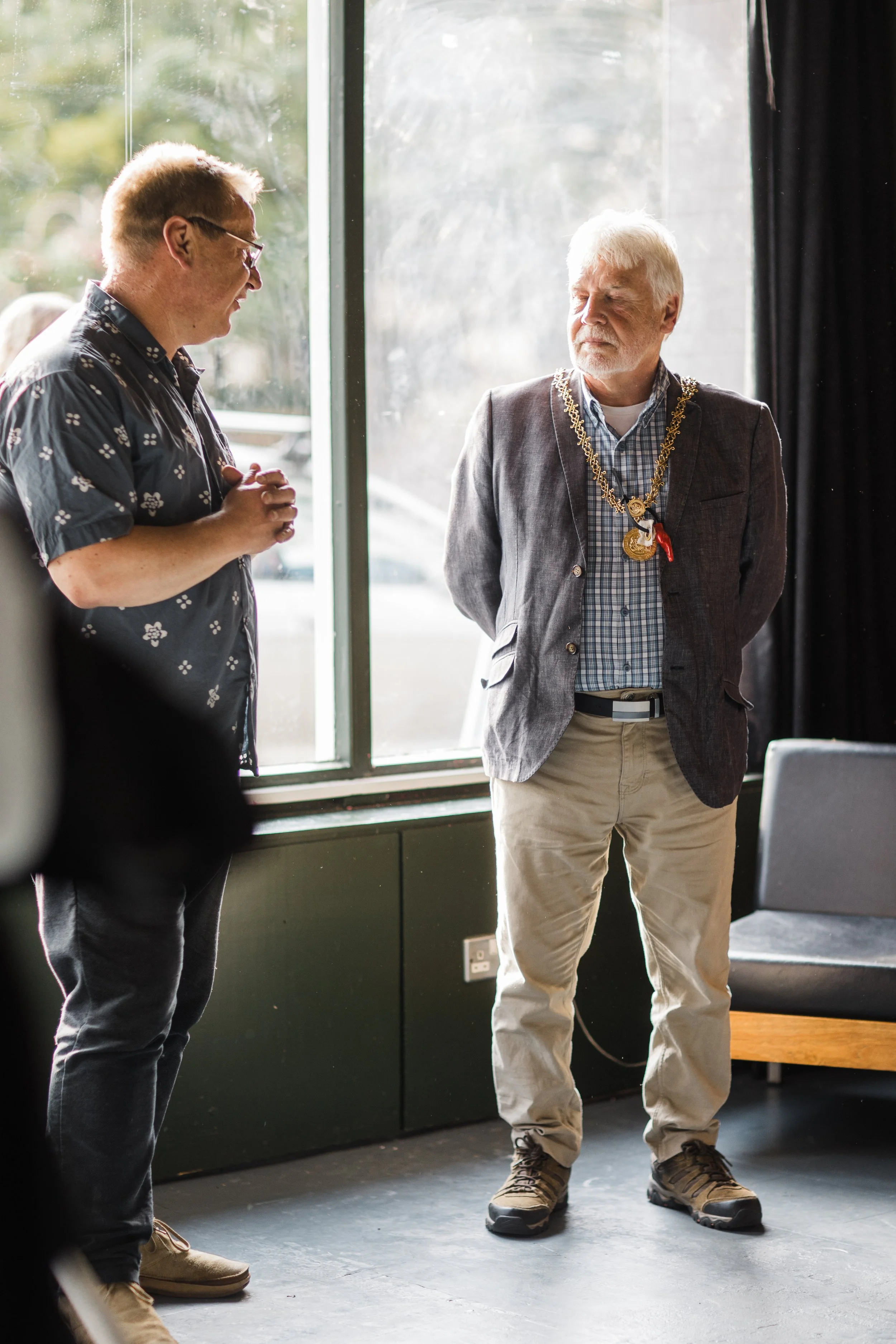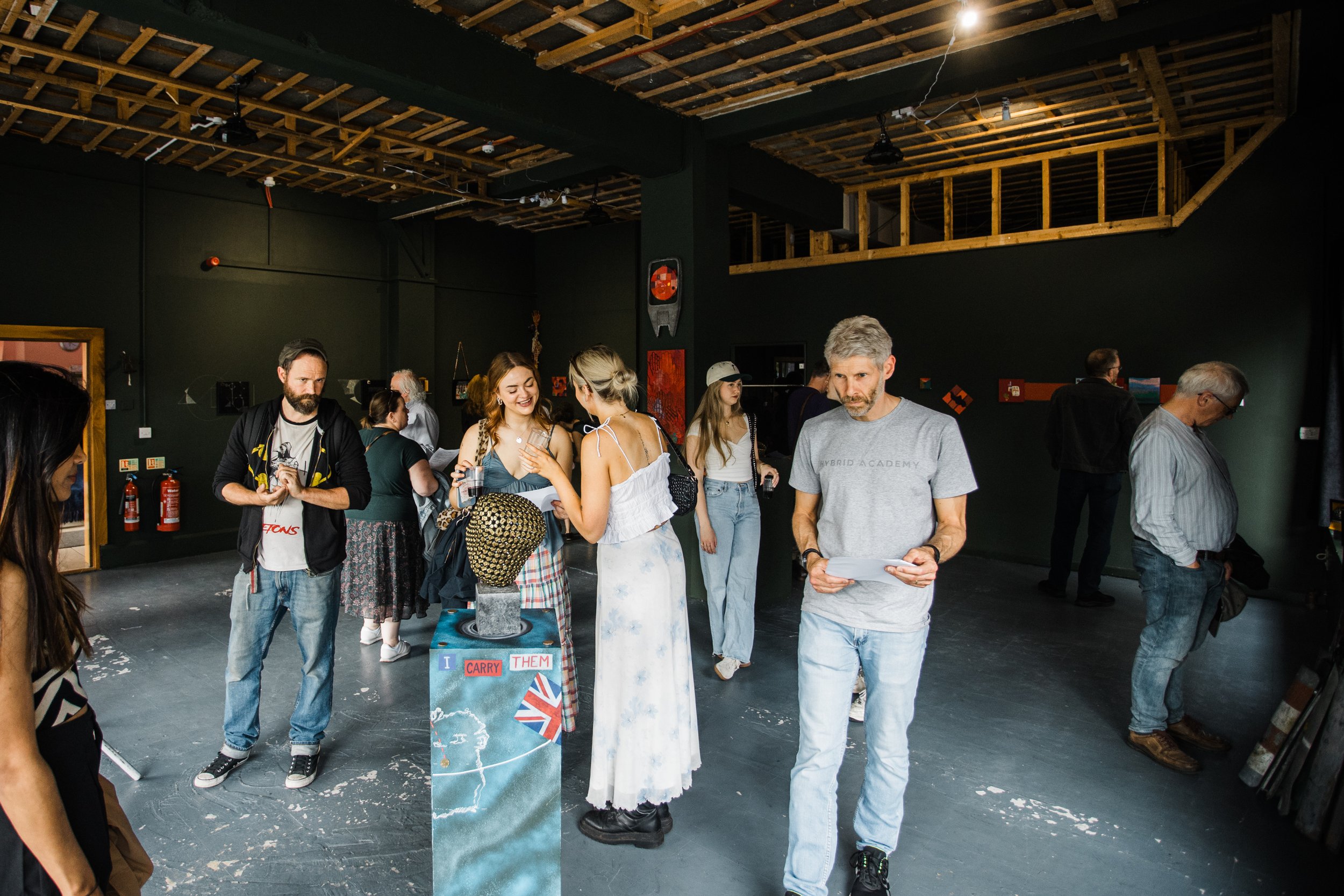‘tRy We Must – The Impossible Task Of Squaring The Circle’
New Work by John Baucher
Vault Artist Studios Gallery | Project Space
Opening event: Thursday 1 August (6–9pm) Late Night Art
Exhibition continues: Friday 2 – Wednesday 14 August (12–6pm)
Workshop: Dates TBC
Flagging the Truth by Rosemary Jenkinson
John Baucher is one of the most playfully transgressive artists on the scene right now. His new exhibition ‘Try we must – the impossible task of squaring the circle’ subverts expectation and expands debate. It is well known that Northern Irish loyalists are the staunchest flag fliers in the UK and Ireland, and Baucher shines a spotlight on this fact by converting retrieved or donated flags and their paraphernalia into striking art.
Baucher is a collector of the ephemeral and his examination of identity, emblems and commemoration conjures up bold questions: should flags be consigned as relics of our colonial past? How can you protect yourself from being nationalistic? Has flag worship led to the isolationism of Brexit? His art is hyperlocal and he is the ultimate streetcomber and urban scavenger. One is likely to find him pounding the Belfast streets at dawn, after the eleventh night bonfire, rescuing flags, the immolated bone-like remains of burnt pallets, melted signposts and scorched warped sections of lamppost. One person’s detritus is an artist’s gold dust. Even the plinths he uses for some of his sculptures are made from Portuguese granite gifted by workmen at a local Glider stop, metres from his city centre studio.
This is art that creates beauty out of ugly or everyday objects in the same way that the film American Beauty elevated the footage of a plastic bag blowing in the wind. In the ashes of a bonfire, Baucher finds aestheticism in the illegal tyres that have polluted it. It is fascinating to see how a tyre has been burnt down into an undulating circle of delicate wires. There are so many powerful images. A skull covered in a patchwork of flag remnants conveys how brainwashed we are by our nationalistic and tribal tendencies. A bow and arrow, featuring a string made of braided flags, reveals the cultural weaponisation of flag culture. A half-burnt Irish tricolour that miraculously survived being incinerated at the top of a Sandy Row bonfire is incorporated in OBE work. The green material is intriguingly bubbled like crocodile skin, but the metaphor could arguably be that loyalism has on this occasion failed to defeat republicanism.
‘Try we must…’ is the culmination of seven years’ work that began with Urban Tracking and has evolved through last year’s highly acclaimed exhibition, ‘Worship the last thread as a relic’. The title of ‘Try we must – the impossible task of squaring the circle’ is inspired by mathematicians who keep on defiantly trying to square a circle and inching closer to a solution. An incremental approach defines Baucher’s own artistic practice. Baucher has always engaged with the local PUL community in a sensitive manner and believes that altering perceptions in a small way can contribute to societal change. While his work challenges preconceptions, he never sets out to offend. As he states himself with tongue-in-cheek black Belfast humour, ‘I’d rather get nominated than kneecapped.’ One of the themes of the exhibition is the commercialism of flag culture and the environmental non-sustainability of discarding them. Thanks to Baucher, some local loyalists have begun to reuse ropes rather than throwing them away. Baucher argues compellingly that flags shouldn’t be left to disintegrate, citing how other cultures dispose of them in flag retirement ceremonies. In the USA, for instance, Scouts burn Stars and Stripes flags in a respectful ceremony and even repurpose flag eyelets as woggles. It’s always worth looking out for Baucher’s signature wit and mischief. Lurking in one display is a lone washer trying to assume the identity of an eyelet. There is even a somewhat kinky whip made out of eyelets and cable ties. ‘Flagpole #2’ is a 2-metre poplar branch wrapped not only in thirty metres of flag braids but in leather from one of the ubiquitous brown leather sofas put out for the council. Few artists would have the imagination and chutzpah to construct a wind chime out of flag holders and lamppost access doors. And what other artist would have the temerity to fuse one of Belfast’s most iconic images, the C. S. Lewis wardrobe, with flag emblems?
The flags range from football to paramilitary and even to tiny antique silk flags from old cigarette packets. Red white and blue may predominate, but the braiding enables you to look at the rich reds, purples, blues and greens with a fresh perspective. One UDA flag for example bears a close resemblance to one of the most famous flags in current world politics, that of Ukraine. Simple iconography is alchemised into a much deeper meditation on our human need for remembrance and commemoration. Baucher’s work with flag fragments is reminiscent of the vibrant cut-outs of Matisse. He combines the symbol of the royal crown with the Irish shamrock to show the many strands of heritage in this country. Words like ‘Division’ are isolated from the ‘Ulster Division’ on UVF flags to interrogate whether flags are divisive or unifying. Baucher himself quotes Samuel Johnson’s words: ‘Patriotism is the last refuge of a scoundrel’, only for it to be undercut in this case with a wry question mark. Baucher’s exhibitions are never stuffy affairs behind glass cases. Try we must includes eyelet sculptures such as a sphere within a cube and a never-ending mobius that exhibition-goers are encouraged to touch. There are deconstructed cubes made from the corner blocks of pallets, 3-D tumbling dice and a Victorian photo album for cartes de visite cleverly converted into an album of flags.
While ‘Try we must…’ tackles wider issues, it is also an exploration of the artist’s own past and identity. Baucher makes his own autoethnographic flag of the townland of Ballylisk in Tandragee where he was born. Flags are habitually manufactured for nations or groups, but the Ballylisk flag goes against the grain by being uniquely personal. Baucher is focusing here on the syncretic nature of belief. All of us have our own temples of memories that we keep on our mantelpieces or journeys we commemorate through fridge magnets – so why not tap into that impulse with the creation of our own flags and memorabilia, fusing our emblems with those of other cultures? A standout piece is the humorously-titled assemblage, ‘Sticking out like a sore thumb’. It consists of a myriad of Red Hands of Ulster cut out of local flags. The Red Hand is a symbol of warrior strength, but its inviolability is ironically dissipated by one rogue blue hand. This piece, for me, evokes how important the image of the hand is in Northern Irish culture – think for instance of the Hands Across the Divide sculpture in Derry that symbolises peace.
The best thing about Baucher’s work, however, is that it doesn’t preach peace or lapse into fashionable sententiousness or spoonfeed hackneyed sentiments. It delightfully disrupts the political status quo and exists to make you think independently and reassess your own relationship to cultural belonging. Baucher has made a cast of his own hand to top his flagpole, but rather than representing the traditional power of the Red Hand image, his fingers are slightly bent to suggest a more ambivalent stance when it comes to national pride. This ceaseless questioning brilliantly underpins the whole exhibition. John Hume famously said ‘You can’t eat a flag,’ but John Baucher proves that you can build a highly meaningful career through flags by displaying them in new ways and transforming them into something infinitely more interesting than their constituent parts. As the artist says himself of ‘Try we must – the impossible task of squaring the circle’: ‘Expect the unexpected.’ This arresting celebration of the hyperlocal richly deserves a global audience.
Rosemary Jenkinson
Workshop & Artist Talk:
To accompany the exhibition John Baucher will give an artist talk and host a participatory workshop, utilising eyelets and cable ties, threads and ephemera from his large collection. Date TBC
Location: Vault Artist Studios Gallery & Project Space. 28 - 32 Victoria Street, Belfast BT1 3GG. Everyone welcome.
About the artist:
Baucher’s durational and considered approach has garnered international attention through selection for Royal Hibernian Academy and European premier of film ‘Language of the Lamppost’ in Lugano Film festival, Switzerland.
His work has been acquired for collection by the Ulster Museum Modern History dept in 2023 and the Arts Council of Northern Ireland's permanent collection in 2024.
Instgram: @moochinphotoman
This exhibition is made possible through the generous support of Vault Artist Studios, Belfast City Council, and Esme Mitchel Trust.


















